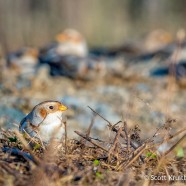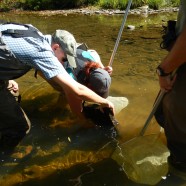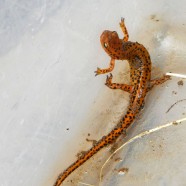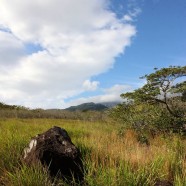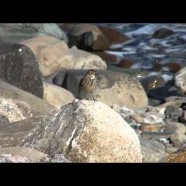Snow Buntings
It is early enough in the avian wintering season that both the earth and the birds – in this case, Snow Buntings (Plectrophenax nivalis) – are brown. We do not have a solid snow cover yet, and it is amazing how well this plumage is designed to help them blend in to the ground. The Snow Bunting camouflage looks like brown grass and, somehow, a rocky, sandy and rough earth, with their wings showing off the darker pattern of what the tundra and short grasslands look like now. Notice how well these birds keep themselves just off the surface even while engaged in feeding, hiding their...
Read MoreWhat’s Under That Rock?
As a little girl growing up in rural Western New York, I always had an affinity for animals. My mom worked at a veterinary clinic and would often take me to work with her where, at a young age, I learned to respect animals and treat them with gentleness and compassion. I also spent a lot of time in the woods going on hikes with my dad and grandpa finding whatever was along the trail or fishing out whatever was in a nearby fishing hole. For the longest time I loved all things furry, with horses, dogs, and guinea pigs being amongst my favorites. But as I grew a little older and spent more time...
Read MoreLong-tailed Salamander (Eurycea longicauda)
Earlier this summer I caught my first glimpse of this handsome salamander, appropriately named the Long-tailed Salamander (Eurycea longicauda). A species of Special Concern in New York State, this uncommon salamander is at the northern fringes of its range and can be found along much of the southern Allegheny Plateau. Long-tails prefer cool woodland seeps and streams, but can occasionally be found along river banks under flat rocks or logs. As the temperatures continue to drop these salamanders will work their way deeper into rock cracks and crevices in order to protect themselves from...
Read MoreRincon de La Vieja National Park
To contrast some of the winter scenery I have posted recently, not to mention the very wet and rainy tropical rainforests our RTPI research crew and friends have been working in during their time in Costa Rica, here is some vastly different habitat in Rincon de La Vieja National Park as photographed by RTPI Affiliate Sean Graesser. You can see noticeably dry forest set against a blue sky and almost feel the flow of these hot springs in front of a tree that looks to be taken directly from fantasy. Scott Kruitbosch Conservation & Outreach Coordinator
Read MoreAmerican Pipit (Anthus rubescens) in HD
Right now the migrating American Pipit (Anthus rubescens) can be found on farms and fields in areas such as Chautauqua County to the shores of Lake Erie or the Atlantic Coast. You may see one individual or you may see dozens. This HD video shows how much they as a species enjoy bobbing their tails. It may be a “drab” bird due to its preference for open areas but it certainly has an understated zest.
Read More



